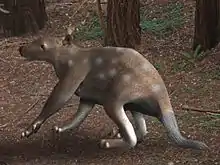Ekaltadeta
Ekaltadeta is an extinct genus of marsupials related to the modern musky rat-kangaroos.[2][3][4] Ekaltadelta was present in what is today the Riversleigh formations in Northern Queensland from the Late Oligocene to the Miocene.[5][6]
| Ekaltadeta | |
|---|---|
 | |
| Scientific classification | |
| Kingdom: | Animalia |
| Phylum: | Chordata |
| Class: | Mammalia |
| Infraclass: | Marsupialia |
| Order: | Diprotodontia |
| Family: | Hypsiprymnodontidae |
| Genus: | †Ekaltadeta Mike Archer & Flannery, 1985[1] |
They are hypothesized to have been either exclusively carnivorous, or omnivorous with a fondness for meat, based on their chewing teeth.[6] This conclusion is based mainly on the size and shape of a large buzz-saw-shaped cheek-tooth, the adult third premolar, which is common to all Ekaltadeta.[7] A few specimens actually did also have long predatory "fangs".
Fossils of the animals include two near complete skulls, and numerous upper and lower jaws.
Taxonomy
The description of a new species and genus was published by Mike Archer and Tim Flannery in 1985. The type species is Ekaltadeta ima. It was originally put within the family of Potoroidae,[8] but like the musky rat-kangaroo, the genus was moved to the family Hypsiprymnodontidae.[2][4][9]
The name Ekaltadeta is derived from two words in an indigenous language associated with the McDonnell Ranges, combining the words for powerful, ekalta, and eta to describe the "powerful tooth".[1]
The species assigned to this genus are
- Ekaltadeta[5]
- Ekaltadeta ima Archer and Flannery 1985;[1] the type species.[3]
- Ekaltadeta jamiemulvaneyi Wroe 1996[3]
- Ekaltadeta wellingtonensis, Archer and Flannery, 1985. Tentatively placed as Proleopus wellingtonensis in later revision of the phylogeny of the subfamily Propleopinae Archer and Flannery, 1985.[3]
References
- Archer, M.; Flannery, T. (1985). "Revision of the Extinct Gigantic Rat Kangaroos (Potoroidae: Marsupialia), with Description of a New Miocene Genus and Species and a New Pleistocene Species of Propleopus". Journal of Paleontology. 59 (6): 1331–1349. ISSN 0022-3360. JSTOR 1304948.
- "QMF12423 Ekaltadeta ima". learning.qm.qld.gov.au. Retrieved 2019-07-19.
- Wroe, S. (1996). "An Investigation of Phylogeny in the Giant Extinct Rat Kangaroo Ekaltadeta (Propleopinae, Potoroidae, Marsupialia)". Journal of Paleontology. 70 (4): 681–690. doi:10.1017/S0022336000023635. ISSN 0022-3360. JSTOR 1306529.
- Wroe, Stephen; Brammall, Jenni; Cooke, Bernard N. (July 1998). "The skull of Ekaltadeta ima (Marsupialia, Hypsiprymnodontidae?): An analysis of some marsupial cranial features and a re-investigation of propleopine phylogeny, with notes on the inference of carnivory in mammals". Journal of Paleontology. 72 (4): 738–751. doi:10.1017/S0022336000040439. ISSN 0022-3360.
- "Fossilworks: Ekaltadeta". fossilworks.org. Retrieved 2017-08-22.
- "Killer Kangaroo". www.wakaleo.net. Retrieved 2017-08-22.
- "Mammals - Fossil Mammals - The Killer Rat-Kangaroo's Tooth". 2008-09-19. Archived from the original on 2008-09-19. Retrieved 2017-08-22.CS1 maint: bot: original URL status unknown (link)
- "Potoroidae". 2007-06-11. Archived from the original on 2007-06-11. Retrieved 2017-08-23.CS1 maint: bot: original URL status unknown (link)
- Wroe, S.; Archer, M. (July 1995). "Extraordinary diphyodonty-related change in dental function for a tooth of the extinct marsupial Ekaltadeta ima (Propleopinae, Hypsiprymnodontidae)". Archives of Oral Biology. 40 (7): 597–603. doi:10.1016/0003-9969(95)00010-M. PMID 7575230.